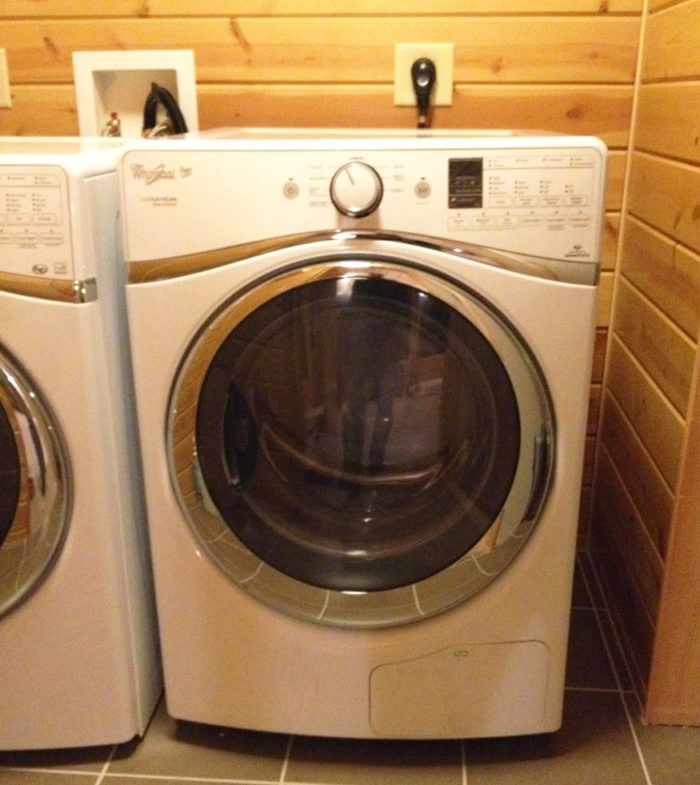
Image Credit: All photos: Joe Rice
Whirlpool announced it back in July; I was able to order it in October; and it wasn’t delivered until January 21st — but I now own a real live, made for the U.S. market, heat-pump clothes dryer. It’s officially the Whirlpool HybridCare Duet Dryer with Heat Pump Technology.
Heat-pump clothes dryers have been available for many years in Europe, but this dryer and another recently announced model from LG are the first to hit the U.S. market. I chose the Whirlpool over the LG primarily because the LG, for some reason, still has a vent to the outdoors. One of the major advantages of incorporating a heat pump into a clothes dryer is that the dryer can be ventless. For a tight building enclosure that means one fewer penetration to be sealed. It also means that the dryer isn’t taking conditioned air from the living space and venting it to the outdoors.
The dryer (see Image #1, above) looks pretty much like every other clothes dryer, doesn’t it? From this angle, the only difference you can really see between a standard dryer and this dryer is the panel at the bottom right which open to allow access to the secondary lint filter.
But look at the washing machine outlet box at left. The two steel-braided hoses and the large black drain hose come from the washing machine. But that small copper tube attached to the small black hose is the drain from the dryer.
I ran a medium-large load using the most efficient cycle and, well, it worked. It didn’t seem to take terribly long (although I didn’t time it) and the clothes came out not just dry but quite soft and with fewer wrinkles than the laundry from the last dryer I owned. In fact, the towels came out positively luxuriously soft. It is a bit louder than your typical dryer, though — something to keep in mind if your dryer isn’t located in an acoustically isolated area of your house.
The real downside to the dryer is the cost. I got it from A. J. Madison for $1,399 with free shipping. That’s a lot for a dryer. Of course, I’ll save money every time I run a load, at least, compared to a traditional dryer, right? To figure out how much I created a spreadsheet. It takes into account the amount of energy each dryer requires to run, the amount of energy a minisplit heating system would use to heat/cool the makeup air (for a venting dryer) and the fact that all of the energy used to run a heat-pump dryer stays in the house. This latter effect is a significant savings in the heating season and a significant cost in the cooling season.
According to these calculations, and based on prices for electricity and gas in Massachusetts, the costs per load are:
| Winter | Summer | |
| Traditional electric dryer | 55¢ | 53¢ |
| Traditional gas dryer | 39¢ | 38¢ |
| Heat pump electric dryer | 17¢ | 33¢ |
For a family that does five five loads of drying a week, that’s a savings of $1.90 per week during the winter and $1.00 per week during the summer for a heat-pump dryer vs. a traditional electric. Averaged out that comes to a savings of about $75 per year, which would bring the total lifetime cost of a heat pump dryer much closer to the cost of a traditional dryer. But unless you live in a very cold climate or dry an excessive amount of laundry, a heat-pump dryer, at today’s prices, is unlikely to save you a lot of money. If prices come down, or if the price of energy goes up, that could change.
While the cost may or may not be an issue, one great feature of this dryer that could turn it into a mainstream product is how much gentler it is on your clothes. Because it’s not using heat alone to dry the clothes, it doesn’t heat the air as much as a traditional dryer. Not only will clothes last longer but it might make it possible to dry clothes that you would otherwise need to hang dry.
How heat-pump clothes dryers work
A traditional dryer works by heating air, blowing it into the drum chamber (where it absorbs moisture from the clothes), and then exhausting the now moisture-laden hot air out of the dryer and out of the house.
A condensing dryer, on the other hand, works by heating air, blowing it into the drum chamber and then pulling that warm moist air from the drum and cooling it to the point that the moisture condenses and drips into a collection tray. The cool dry air is then heated and recirculated back into the drum where it again picks up moisture and the cycle continues.
The tricky thing with a condensing dryer is how to cool the air being pulled from the drum. Some condensing dryers use a metal plate that is air-cooled and some use a scheme that requires a steady supply of cold water. Neither of these systems results in a dryer that is any more energy-efficient than a traditional dryer, and the appliances are much slower. The market for condensing dryers has typically been for apartment buildings where running an exhaust vent isn’t feasible.
A heat-pump dryer is a kind of condensing dryer. Like pretty much every heat pump device, the heat pump in a heat pump clothes dryer has a cold coil and a hot coil. This works out perfectly for a condensing dryer as the cold coil can be used to cool the warm moist air coming from the drum (and to provide a condensing surface for the moisture in the air) and the hot coil can be used to heat the air before sending it back.
Heat pump clothes dryers use 40% to 50% as much electricity as a traditional electric dryer and dry clothes much faster than condensing dryers that don’t use heat pumps, while still being slower than a conventional gas or electric dryer.
Joe Rice is a retired software engineer who recently moved into his energy-efficient house in eastern Massachusetts. His blog about the construction and performance of the house is called Pretty Good Lake House.
Weekly Newsletter
Get building science and energy efficiency advice, plus special offers, in your inbox.






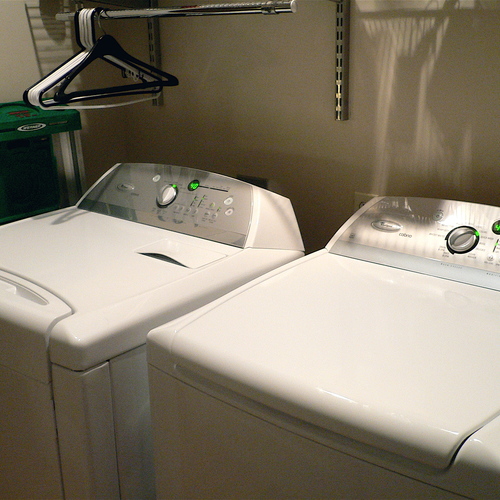
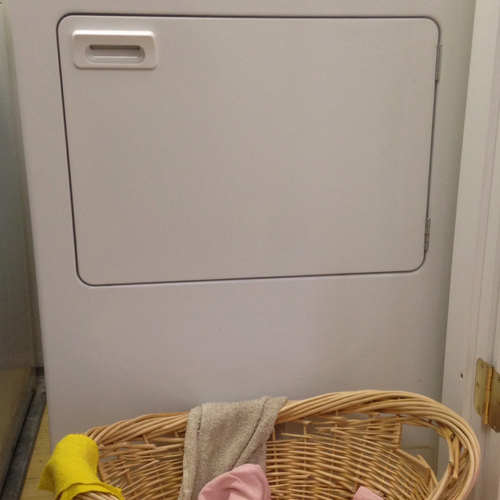
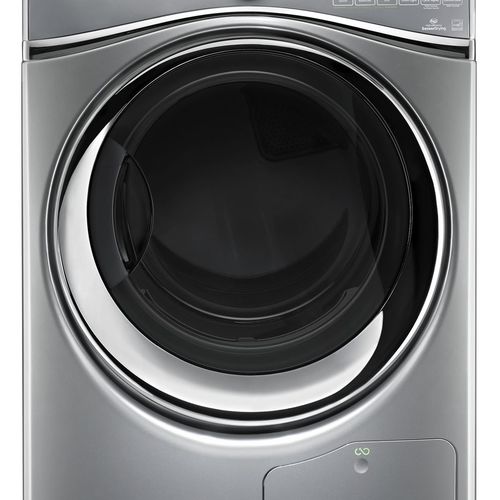
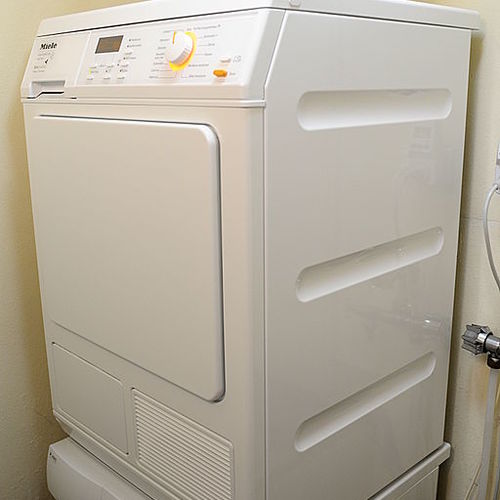






26 Comments
Nice analysis
Terrific analysis, and very impressive how low the net cost is for the heat pump dryer in the winter. In the summer, an outdoor clothesline can be fairly easily used. I suggest one addition to the comparison chart: using a clothesline indoors. That's usually considered free, but that's not quite true, because you have to make up the evaporative cooling with the mini-split heating system.
You might then conclude that a heat pump dryer is a waste of money because you can just use a clothesline, but you can also think of it the opposite way: It's awesome that the heat pump dryer can get close to the performance of a clothesline.
I would be very concerned
I would be very concerned about durability of "new" technology, these days durable goods are made incredibly cheaply and can often have repairs exceeding the cost of replacement (and parts are often discontinued as soon as the next model comes out).
This is not a knock against the technology, but the poor business ethics of manufacturers today, This is easy to fix, simply design with longevity instead of planned short term obsolescence, but today this is an antithetical concept.
Interesting article - didn't
Interesting article - didn't realize this tech was already to market in the US. Hopefully for early adopters here in North America the 'new' technology kinks have been worked out already in Europe.
The natural gas prices are quite high ($1.50/therm), surprising, thought the prices nationally didn't vary all that much. Also are notice your summer/winter gas drying costs are nearly identical, are you seeing that high of gas prices even in the summer?
Natural gas prices
Nick T,
I believe I used $1.40/therm in the spreadsheet which is actually below the current price in Massachusetts where I live. New England is currently experiencing a natural gas shortage which has driven up prices of natural gas as well as electricity. It's ironic in that fracking has dramatically increased the amount of U.S. produced natural gas, but apparently the pipelines into New England are inadequate to meet the demand.
Anyway, that's exactly why I published the spreadsheet - so folks could see the many assumptions behind the numbers.
New England Gas FYI
Joe -- FWIW there is a strong argument that the gas pipelines within New England are adequate to meet New England demand however the shale gas is now being pumped *though* New England for export via Nova Scotia to overseas customers who are willing to pay more then New England is:
http://www.masslive.com/news/index.ssf/2015/02/western_mass_pipeline_foes_fig.html
Can we contact each other offline.
Joe, I'm interested in talking more with you about the heat pump dryer offline. Research experiments, if you are interested and GBA will do so - can you e-mail me. Taunton Press has my e-mail, hopefully Martin or one of the editors could provide it to you.
Thanks.
LBL Study on Heat Pump Dryers
Thanks for sharing your heat pump dryer analysis. I ran across this August 2010 report from LBL and didn't see it mentioned on GBA.
http://eetd.lbl.gov/sites/all/files/do_heat_pump_clothes_dryers_make_sense_for_the_us_market.pdf
The LBL conclusion: "The results show that HPCDs (heat pump clothes dryers) have positive economic benefits only for households with high clothes dryer usage or for households with high electricity prices and moderately high utilization."
It will be interesting to see how your real world results compare to the LBL study.
30 Amps vs. 30 Amps...
I've checked specs for several heat pump dryers- Duet is 30A draw, LG is 26A,, Bosch WTY88700AU says 220-240V, 1000W "connection rating" & 10A current, whatever that combination means. One page on Asko said 13A, another was the 220V/ 900W connection/10A draw type spec. Unfortunately, some give capacity in kG, others in Cu. Ft.
Anyway, the LG & Duet specs are pretty much the same as my 25 year old electric resistance dryer, while the Asko and Bosch are 1/2 to 1/3 the amps. So what gives? If the Duet really puts 30A into a heat pump, it should be drying (& toasting) a full load in 20 minutes.
Response to Robert Fankhauser
Robert,
The amp rating for an appliance is the maximum power draw. It does not indicate average power draw. Nor does it indicate how much energy is required to dry a load of clothes.
I can imagine a variety of reasons why an energy-efficient appliance might have a very high maximum amp rating. For example, there might be an electric-resistance element that is rarely energized, or used for only a brief period during the drying cycle.
Response to Robert Fankhauser
The Duet and, I believe, the LG as well, have settings that basically let you choose between heat pump and resistance drying (and possibly both simultaneously). So it's not surprising that the maximum current draw is as high as a straight electrical resistance dryer.
My guess is that they felt the U.S. market required options for faster drying.
Hybrid operation
I'm not too concerned about exhausting heated air. For years, during the heating season, I have vented the clothes dryer through additional filters and into the return plenum of my furnace, with the blower on during drying cycles. Thus I humidify the house while using no outside air. The energy cost (KWH to evaporate water) is the same as my central steam humidifier, so effectively clothes drying is free. During the cooling season, however, I'm exhausting cooled and dehydrated air, which is being made up by hot, humid air infiltration. A dehumidifying dryer during the cooling season would provide year-round savings, if it has an option for external venting; it appears the Whirlpool model does not; I'm wondering if that's why so many of the reviews complained about it making the laundry room into a sauna. I don't see the summer energy calculations in the linked spreadsheet. I'd like to get a copy, and enhance it with calculations for HVAC cooling savings. In my area of the country, with dew points near 70 degrees, that means a lot of energy is used for latent heat removal of make-up air with vented drying. Any energy used by this dryer will only have to be offset by sensible cooling of the main AC.
Response to Edward Mayercik
Edward,
You've come up with a system that works for you, and I'm not going to try to convince you to change your ways. However, it's worth pointing out that any house with a central steam humidifier has problems, and probably suffers from a very leaky thermal envelope. Leaky houses are much more likely to be dry in the winter than tight houses.
GBA readers: It's usually not a good idea to try to vent a clothes dryer indoors.
1. If it's an electric dryer, the exhaust from the dryer includes lint and lots of moisture.
2. If it's a gas-fueled dryer, the exhaust from the dryer includes combustion products, lint, and lots of moisture.
3. If you want to try Edward's experiment in your house, you have to be vigilant about cleaning your lint filters.
4. Edward's experiment works best in very large homes with few occupants -- especially leaky ones -- and is a particularly bad idea in small homes with many occupants -- especially well-built ones. Adding moisture to the interior of a house raises the chance that your wall sheathing could rot.
Durability and flexibility
First to Martin: item #4 while I already share my home with a well-built occupant, I'd be concerned about sharing it with a leaky occupant.
Seriously though, I understand Alan B's concern about durability. I just got rid of a 40-year old washer that I could repair myself, the few times that it ever needed repairing (I wasn't skilled enough to rebuild the motor). I wound up replacing it with another older washer because of what I've read about Energy Star appliances durability and the cost of repairs. When you consider embodied energy, there is no way that I see that they save money or resources. Furthermore, every time I considered buying a front loader, I found that it did not have the flexibility to be used the way my simpler machine could be used, because of its strong bias toward saving water. I like to avoid stinky polluting dry cleaning of all woolens that we wear to cut heating costs, but that requires having complete control of the water level in a washer, and using more of it than allowed by HE machines. Similarly, with clothes drying: it is so quick and easy to hang the large or heaving items (either inside or outside) and to use a dryer for the small stuff that is so boring to hang, that I could never justify buying anything but a very basic (not smart) dryer. I enjoy new technology when it's not trivial, and look forward to eventually being able to buy durable energy-saving appliances that don't over promise.
Three years out, does anyone have additional comments about the (ventless) heat pump dryer? We are building a house that we are trying to air seal as tight as possible (no blower door tests yet, but we will definitely not be at passive house standards). The premium cost of the ventless heat pump dryer is such that we may never "break even" for direct energy cost savings. But is it worth it for other reasons to not punch another hole into the side of the house? (We are in climate zone 5.)
Judy
I don't think this helps you in your current situation but I'm personally holding out for the ultrasonic dryer that General Electric and ORNL are bringing to market. No vent, far lower energy usage, and faster drying times than electric resistance. Still a few years out though. Doesn't sound like you can wait that long...but maybe put in a standard dryer and then upgrade to ultrasonic and patch up your hole in a few years...
I'm skeptical of this. I think the phrase "are bringing to market" is inaccurate. From what I can tell, they are still in R&D phase, and it remains to be seen whether it ever becomes a product. They don't even have a prototype of something that would resemble an end product. While the concept seems plausible on the surface, their promotional video is very reminiscent of such past faux-products as the Waterseer, Fontus, and Solar Roadways. Even if the results they've seen so far are true, and they manage to scale this up to a large press-type dryer, no one is going to use that. There's a vague suggestion of eventually developing a drum dryer based on the technology, but that is where they're truly just speculating. It's not at all clear whether that's practically possible, or just a pipe dream. There's a big leap between laying a single piece of clothing on an array of piezoelectric transducers, and having clothes tumble around a drum, with intermittent contact to any transducers. Maybe there's a way that will work, but like I said, it's not a clear path.
@Ethan Foley: A quick bit of googling indicates the ultrasonic dryers are not yet available. Do you have any updated info on this?
The biggest potential savings you get with a ventless dryer is the elimination of pulling in cold air into the house in winter (or hot air in the summer, but even better is just using a clothes line in the summer). This is covered in the article above, but I don't see any mention of the continual losses you will have through that vent when the dryer isn't running. That might be hard to estimate, but it will be substantial.
We have a Whirlpool WED99HEDW, and been using it about 8 months. Very pleased with it. It's a little louder than a conventional dryer, and the cycles are longer. Contrary to what we read, the clothes come out warm (and bone dry), even on the most economic setting. (We read that the clothes are cold, and therefore don't "feel" really dry.) Only complaint is that it's really big. We'd have preferred a more modest size, but the deal we got could not be passed up.
Because it was discontinued, we got the best possible deal on it, which was $0. They had a clearance sign on it, but no price, so I asked the sales guy how much. He said if I bought the matching washer (also on clearance for half price), he'd give me the dryer. We needed a washer too, so pretty easy sale. The washer and dryer were about 40% less than the next cheapest dryer alone.
The good news is that the price has come down a lot in the last couple of years. I see several at HD for under $1000. LG even has an all-in-one, washer-dryer. That one isn't a heat pump though, just a condensing ventless. Not sure how that compares energy wise.
Well, I've now owned this dryer for almost 5 years and it's still working perfectly but I have to say there are a few downsides. Having to clean the secondary lint filter is an annoyance - at least partly because I feel a need to be particularly thorough due to the second issue. Despite having a secondary lint filter, lint still gets through and accumulates on the heat pumps coils. Although they're easily visible through a screen there's no simple way to clean the coils. So far (and surprisingly) this doesn't seem to be affecting the dryer performance but it must eventually. I'll be finding some way into the dryer soon to clean the coils but that's not something most people will want to do.
I'm sorely tempted to just cut the bug screen material they have in front of the heat exchanger, clean the lint and then seal it up again. Or just remove it altogether. I can't really imagine what good it is doing.
@Trevor Lambert: Did you ever end up doing this?
Would having a heat pump water heater in a room adjacent to the laundry room with a heat pump dryer work synergistically to improve performance of both of them?
Yes. Both rooms still need to communicate with the rest of the house, though.
What about the energy savings in a climate like Florida where the air conditioner is running 9-10 months a year? I assume the heat pump dryer outputs cold air in effect acting like a small air conditioner in the room where it operates? A conventional dryer running in the house generates a lot of heat load that then has to be removed by the house ac system.
@lburrguiere: Your theory sounds correct. However, having just acquired a heat pump dryer, in practice I don't it offers any cooling benefit. The Whirlpool heat pump dryer gets very warm all around the exterior, and noticeably heats the area around it. While I was expecting it to act like a mini air conditioner while the heat pump removes the heat from the air in the room to put it in the dryer, in reality, the enclosure of the dryer gets so warm that it transfers that warmth to the room.
@JoeRice: My Whirlpool WHD560CHW came with different set of instructions than the one linked to online at the source from which I accessed the online manual before ordering. Perhaps this is because Whirlpool does not even have the WHD560CHW instructions on their own site.
These extra instruction state "From Inside the Dryer Cabinet Lint should be removed every 2 years, or more often, depending on dryer usage. Cleaning should be done by a qualified appliance servicer."
I was not expecting this additional maintenance requirement. Fortunately my household uses the dryer less than typical so I may get by with doing this less frequently. Also, the dryer is placed so that I can try to move it out of its nook with a handtruck and open the housing to do this myself. However it certainly increases the cost and inconvenience of ownership. Not entirely sure I would have bought this one had I known...
You are correct that a heat pump dryer delivers a small amount of heat to the house, equal to the energy in the electricity it uses. The impact on A/C load is, however, much less than running a convention dryer: if the dryer exhausts 150 CFM, that means 150 CFM of hot, humid outdoor air comes in to replace it.
It's also possible that the heat-pump dryer does some dehumidification of the room air, providing a bonus that way.
Log in or create an account to post a comment.
Sign up Log in